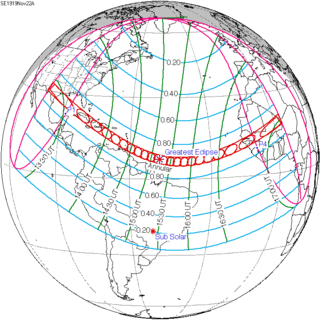| Solar eclipse of November 22, 1919 | |
|---|---|
| Type of eclipse | |
| Nature | Annular |
| Gamma | 0.4549 |
| Magnitude | 0.9198 |
| Maximum eclipse | |
| Duration | 697 s (11 min 37 s) |
| Coordinates | 6°54′N 48°54′W / 6.9°N 48.9°W |
| Max. width of band | 341 km (212 mi) |
| Times (UTC) | |
| Greatest eclipse | 15:14:12 |
| References | |
| Saros | 141 (18 of 70) |
| Catalog # (SE5000) | 9327 |
An annular solar eclipse occurred at the Moon's ascending node of orbit on Saturday, November 22, 1919,[1] with a magnitude of 0.9198. A solar eclipse occurs when the Moon passes between Earth and the Sun, thereby totally or partly obscuring the image of the Sun for a viewer on Earth. An annular solar eclipse occurs when the Moon's apparent diameter is smaller than the Sun's, blocking most of the Sun's light and causing the Sun to look like an annulus (ring). An annular eclipse appears as a partial eclipse over a region of the Earth thousands of kilometres wide. Occurring only 11 hours before apogee (on November 23, 1919, at 2:20 UTC), the Moon's apparent diameter was smaller.[2]
The duration of annularity at maximum eclipse (closest to but slightly shorter than the longest duration) was 11 minutes, 36.56 seconds in the Atlantic Ocean north of Brazil. It was the longest annular solar eclipse since January 5, 1647, but the Solar eclipse of December 2, 1937 lasted longer.[3]
Places inside the annular eclipse included North America and the Caribbean, including Austin, San Antonio, Houston and Galveston, Texas in the United States and was close to Mexico at around 7:30 CT (13:30 UTC), more than a quarter of the Gulf of Mexico and close to the Florida Keys in the United States which occurred before 8:45 ET (13:45 UTC), it also included Cuba, most of Haiti and the southwesternmost Dominican Republic, it was almost near Venezuela and it included Saint Vincent and the Grenadines and Barbados which happened in the mid morning hours. The greatest eclipse occurred at 15:14:12 UTC. In Africa, it included the Gambia, southern Senegal including Casamance, Portuguese Guinea (now Guinea-Bissau), the northern part of French Guinea (now Guinea) which occurred before 15:45 (16:45 UTC) and southeasternmost Mauritania and the middle portion of the French Sudan (now Mali) which included Bamako and Timbuktu, it occurred in the late afternoon before sunset at 17:00 UTC. A partial eclipse was visible for parts of North America, the Caribbean, northern South America, West Africa, and Western Europe.
- ^ "November 22, 1919 Annular Solar Eclipse". timeanddate. Retrieved 1 August 2024.
- ^ "Moon Distances for London, United Kingdom, England". timeanddate. Retrieved 1 August 2024.
- ^ "Annular Solar Eclipses with Durations Exceeding 11m 00s: -3999 to 6000". NASA Eclipse Web Site.
